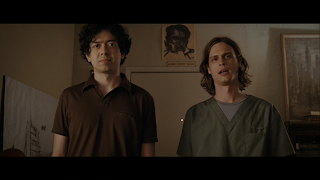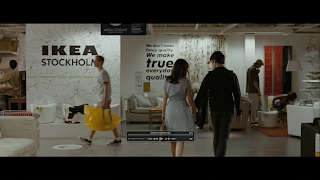The film starts with the two lovers on a bench sharing an intimate moment and a close-up of the girl’s hand with a wedding ring placed on it. A narrator’s voice is added which outlines the story of the two main characters, switching from their youth to their current age. This is a small short interval before the film actually starts that outlines what is to come and what to expect throughout this film. There are a lot of credits at the beginning of this film which take up much of the time but the interval at the beginning was a useful device for showing the audience who each character is and small traits of their personalities. Although little happens within the first two minutes, we do get the impression that the main male character is deeply in love and that his girlfriend may prove to be harder to please after all.
The average apartment building and city setting is a good and standard location to film a love story in. The audience can foreshadow that the relationship between the two main characters won’t be as good as appeared on paper and this first two minutes will convey this clearly.
I started my two minute analysis when there is a sharp fade in from the credits into the opening low angle shot of a fast moving bicycle. The low angle shot used on the bike making the bike appear close and seem very rapid. This follows with a more appropriate establishing and long shot capturing the figure, the bicycle and the backdrop to give the audience a sense of location. It is dark and the road is deserted and a city is near by. The figure appears to be in a rush, which foreshadows there is an emergency at the destination she is cycling to. A POV shot of the road on which the figure is cycling on appears which makes the audience feel as if they were on the bike. Additionally it gives the bike a sense of its actual speed.
Once arrived at the anonymous destination the audience is introduced to the first character that appears to be a little girl. A mid-shot is used to present her but at once gives the viewer a sense of where the character is. From her short height we gather she is a child – a wise child one would assume as she is out at such a late time. Once arrived where she is actually going to, we are again introduced to two other new characters very briefly and informally. The camera follows the young girl up to the apartment where the audience is left to think is her final destination. During this the camera has not revealed her face so her appearance is still a secret to the viewer. A POV shot of the girl is used so her back is facing the camera and we see her in the point of view of the two men. This is followed by a mid-shot of the two men where the audience gains a sense of the male’s features making the audience assume they are also two key characters in the film. A close-up of the girl’s face is used to emphasise her reactions at this given point.
The main character that this whole scene has been built up to meet is introduced from a mid-shot to a close-up. The mid-shot presents what the male figure is doing and his type of body language. Additionally, the close-up shows the male’s emotions and current state of mind, which appears to be angry and upset. A group shot is then used. This shot is important because it creates an evident link between all the characters we’ve met so far and the setting of their seating plan shows that the current situation is revolved around him.
Finally, the problem is revealed and the camera turns to his memories of himself and his girlfriend. The shots that follow are 5 scenes of two-shots. These shots establish a clear representation of the two characters’ relationship. They are needless to say, lovers. They share the same space in a camera shot on many accounts sharing intimate scenes such as, kissing, holding hands, hugs and close eye contact. To conclude their intimate love affair scenes a shot over the male figures shoulder is used, which shows a conversation, is being taken place. An immediate sense of space between the characters is obvious as a table is used to bar off their close proximity to one another. Because of this extreme change in mise-en-scene the audience feels their distance.
Screen Shots – 500 Days Of Summer
Opening low angle, demonstrating the speed of the bike, suggesting where the person is going is an emergency.
This establishing shot is a long shot that shows the wide empty road suggesting it’s late and again reinforces the emergency. The city shows the audience that this is going to be a young adults city life and location setting.
This is a Point Of View shot of the bike’s view point which in this shot shows the actual speed of the bike and brings focus to what’s happening on screen.
We take note on the difference in height of the three characters, so it is easy to work out the age differences. The two men have their back to the cameras as does the young girl but she dominates this shot.
A mid-shot of the two young adults is used who both appear to be stereotypical ‘best friend’ type of people. The shot also shows their scruffy costumes convey they may not take anything too seriously.
A medium close-up of the young girl finally fully reveals her face and shows her age off. Her facial expression appears to be a worried face which foreshadows the answer of the emergency will shortly be revealed to the viewers.
Another close-up is used to introduce the audience to the main character. It reveals his face emotions which are distressed and confused. The shot also allows us to see what he’s holding which appears to be a plate, which is a classic item to break when breaking down.
The group shot shows the characters all together in one space. The girl is still dominating which shows her power and reinforces the young adult’s lack of maturity when it comes to minor dilemmas.
A shot over the shoulder is a typical way to film conversations; this makes it an easy watch and feel like a normal conversation for the viewer.
Extreme close up and two shot of the two lovers (main characters) share a kiss. This establishes their relationship.
A long shot of the two lovers shoots their relationship again when holding hands. The location they are placed in gives the audience hints of what sort of relationship they are in. Ikea (being a furniture store) may perhaps hint they live together suggesting it is a serious relationship.
A final close-up shot in bed again reinforces to the audience the sort of relationship the two lovers have.
Titles and Credits – 500 Days of Summer
There are countless separate title sides before the film actually begins. The first two are production and distribution company credits. The next eight names are all of actors in the film of which the three most famous actors names are listed first. The slides then move on to casting manager, film director and makeup and costume artists…there is a simple cut between the slides. The colour scheme is a black background. Next to the writing you find various pictures of the main characters, making it very quirky and personal. These title slides are intended to provide the necessary information but in this case have intentionally added the pictures to add a unique feature to this particular film.
Use of Sound – 500 Days of Summer
The interval at the beginning, before the credits use a deep male narrative voice who explains to the audience what is going on in a rather comical way. None of the actors’ dialogue happens during this short scene, which is a clever technique as the audience is waiting for the film to commence but little do we know this is not the film. This scene is followed by the credits using a quirky, girly song by Regina Spektor suggesting the film genre, which conveys a happy film with the upbeat tone of the track. The atmosphere established by the music is content and reflective of the film itself, and seems to tie in with the ‘summer’ part of the title. This ends with a clear piano ending and immediately jumps into a racy almost animation or cartoon like music on top of the sound perspective of the speeding bicycle.
He begins to explain his dilemma. Again music is used when he is describing things to the group. Throughout this the music is synchronous sound as the music unlike before has more of a long lost memory tone to it suggesting that the problem revolves around him and his girlfriends relationship.















No comments:
Post a Comment